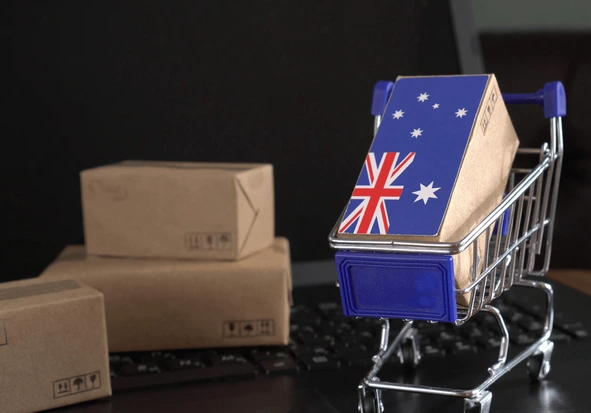
That bargain you found on a US website for under $800? From 29 August, Americans will be paying extra taxes on it, regardless of how small the purchase. While this rule targets US consumers, the ripple effects of Washington’s trade war are still reaching into Australian pockets in ways many don’t yet realise.
The US has imposed a 10 per cent baseline tariff which took effect from 12:01 am on 5 April 2025 EDT (3:01 pm Saturday 5 April AEST).
Most goods originating in Australia are now subject to this 10 per cent tariff when imported into the United States.
But the story doesn't end there. These tariffs are part of the most sweeping trade restrictions imposed by the US since the 1930s, creating ripple effects that touch everything from your grocery bill to your investment portfolio.
The tariff web that's changing everything
What started as targeted measures has evolved into a complex web of trade restrictions that would make even seasoned economists reach for their calculators. The 10 per cent baseline tariff is now in place on most imported goods, affecting Australian exports since 5 April 2025.
And that’s just the beginning. Australian steel and aluminium imports to the US are subject to a 50 per cent tariff from 4 June 2025. Some copper and copper-containing products face a 50 per cent tariff from 1 August 2025.
These aren't small-scale industries either—as the sixth-largest producer of aluminium globally, Australia plays a significant role in the industry. Last year, Australia exported 223,000 tonnes of steel and 83,000 tonnes of aluminium to the US.
'The overall effect is going to be negative'
The numbers paint a stark picture. From January to April 2025, the average applied US tariff rate rose from 2.5 per cent to an estimated 27 per cent—the highest level in over a century since the Smoot–Hawley Tariff Act. After changes and negotiations, the rate was estimated at 18.6 per cent as of August 2025.
What the de minimis change means
From August 29, 2025:
- US shoppers lose their $800 duty-free allowance
- More delays at US customs are likely
- Australian exporters could see weaker US demand
- Some retailers may rethink international shipping due to complexity
U.S. consumers may pay more for international purchases because tariffs will apply to items that previously qualified for duty-free status. The same logic applies in reverse—when Americans face higher costs for Australian goods, it reduces demand and puts pressure on Australian exporters.
The price impacts are already being quantified. Across all 2025 tariffs, US household costs are expected to rise by 2.3 per cent in the short run, equal to an average household loss of $3,800.
Annual losses for households at the bottom of the income distribution are $1,700. While these figures relate to US families, global supply chain disruptions mean some flow-through inflation is likely worldwide.
Australia's measured response: Why we're not hitting back
Prime Minister Anthony Albanese's response has been notably restrained, and there's sound economic reasoning behind it. Tariffs and escalating trade tensions are a form of economic self-harm and a recipe for slower growth and higher inflation.
This is why Australia will not be imposing reciprocal tariffs on the United States. Such a course of action would only push up prices for Australian consumers.
The government has instead announced a $50 million support package to help affected industries find new markets, alongside measures to strengthen anti-dumping protections. Australia has no new tariffs on goods from the United States.
Our Government will continue to put forward a strong case for an exemption and to advocate for Australian trade with the United States at every level and through every channel.
This diplomatic approach reflects both Australia's long-term strategic interests and practical economic realities. Australian steel and aluminium exports to the United States represent less than 0.2 per cent of the total value of our exports. Neither is in the top 10 of what Australia sells to the United States.
The silver lining: New opportunities emerging
While the immediate impacts are concerning, economists are identifying potential benefits through what's called 'trade diversion.' Australia could see increased trade with Indo-Pacific partners due to trade diversion effects.
This is already happening in some sectors. The latest data shows beef exports to China jumped 43 per cent from January, to Japan up 27 per cent, and to South Korea up 60 per cent from the previous month.
The Reserve Bank of Australia offers cautious optimism about our resource exports. On balance, the effect of higher tariffs on Australian exports is expected to be relatively small and largely on prices rather than volumes.
This is because Australia's exports are dominated by resources for which Australia is a relatively low-cost producer, and because Chinese fiscal policy is expected to support commodity prices.
How tariffs might actually help some Australian consumers
- Chinese goods may become cheaper in Australia as suppliers redirect from the US market
- Increased competition could lower prices for manufactured goods
- Australian exporters are finding new, growing markets in Asia
- Our resource exports remain largely protected due to global demand
What this means for your household budget
Treasury modelling indicates the direct effects of the tariffs on Australia will be small. However, price increases could ripple through to Australian consumers, especially for goods imported from the U.S. The most immediate impact will be felt by exporters and by investors watching global markets.
Beyond shopping, retirees with diversified investment portfolios may notice impacts on international shares.
Australian investors reacted swiftly, wiping 2.1 per cent off the main stock market index, the S&P/ASX 200, in the first hour of trade.
Still, there’s reason for measured optimism. Very high US tariffs on China could push Chinese suppliers to redirect goods to other countries, including Australia. This could increase the supply of goods from China and reduce prices for Australians.
Looking forward: What comes next
The trade war shows no signs of immediate resolution, with both economic and political factors driving continued tensions. On 29 May, the United States Court of International Trade declared the new tariffs illegal.
The Presidential Office immediately lodged an appeal, and the Court confirmed that the tariffs remain in force during the appeal process — including the 10 per cent tariff on Australian goods.
For Australian consumers and retirees, the key is staying informed and adaptable. While the impact of US tariffs on the Australian economy is expected to be negative, Dr French warns against reactionary protectionist policies that could have long-term consequences for Australia's economy.
Instead, he advocates for temporary, targeted support measures to cushion the immediate impact while recognising opportunities for trade diversification in the Indo-Pacific region.
The government's restrained approach appears to be paying dividends in maintaining trade relationships elsewhere. Australia already has trade agreements with most of its Indo-Pacific trading partners. This could also present opportunities for Australian manufacturers.
What This Means For You
While the headlines focus on trade wars and tariff battles, the practical reality for most Australians is more nuanced. Our economy's structure, diplomatic approach, and existing trade relationships provide buffers against the worst impacts.
The challenge now is navigating this new reality while remaining alert to opportunities that emerge from shifting global trade patterns. For a generation that's weathered economic storms before, it's another chapter requiring both caution and adaptability.
What's your experience been with US tariffs affecting your household budget or online shopping? Share your thoughts and help fellow members understand how these changes are playing out in real Australian homes.
Original Article
http://au.news.yahoo.com/us-tariff-rule-hit-aussies-094345439.html
Latest on US tariffs | Australian Government Department of Foreign Affairs and Trade
Cited text: The US has imposed a 10 per cent baseline tariff which took effect from 12:01AM on 5 April 2025 EDT (3.01pm Saturday 5 April AEST). Most goods origina...
Excerpt: The US has imposed a 10 per cent baseline tariff which took effect from 12:01AM on 5 April 2025 EDT (3.01pm Saturday 5 April AEST).
https://www.dfat.gov.au/trade/trade-and-investment/latest-us-tariffs
Latest on US tariffs | Australian Government Department of Foreign Affairs and Trade
Cited text: The US has imposed a 10 per cent baseline tariff on most imported goods, effective 9 April 2025. Most goods originating in Australia are subject to th...
Excerpt: The US has imposed a 10 per cent baseline tariff on most imported goods, effective 9 April 2025.
https://www.dfat.gov.au/trade/trade-and-investment/latest-us-tariffs
Latest on US tariffs | Australian Government Department of Foreign Affairs and Trade
Cited text: Australian steel and aluminium imports to the US are subject to a 50 per cent tariff from 4 June 2025.Some copper and copper-containing products are s...
Excerpt: Australian steel and aluminium imports to the US are subject to a 50 per cent tariff from 4 June 2025.
https://www.dfat.gov.au/trade/trade-and-investment/latest-us-tariffs
State of U.S. Tariffs: August 7, 2025 | The Budget Lab at Yale
Cited text: Labor Market Effects: The unemployment rate rises 0.3 percentage point by the end of 2025 and 0.7 percentage point by the end of 2026.
Excerpt: as the sixth-largest producer of aluminium globally, Australia plays a significant role in the industry.
https://budgetlab.yale.edu/research/state-us-tariffs-august-7-2025
State of U.S. Tariffs: August 7, 2025 | The Budget Lab at Yale
Cited text: Long-Run Sectoral GDP & Employment Effects: In the long-run, tariffs present a trade-off.
Excerpt: as the sixth-largest producer of aluminium globally, Australia plays a significant role in the industry.
https://budgetlab.yale.edu/research/state-us-tariffs-august-7-2025
How US tariffs impact Australia and what policymakers can do
Cited text:
Excerpt: From January to April 2025, the average applied US tariff rate rose from 2.5 per cent to an estimated 27 per cent—the highest level in over a century since the Smoot—Hawley Tariff Act.
https://www.unsw.edu.au/newsroom/ne...impact-australia-and-what-policymakers-can-do
Latest on US tariffs | Australian Government Department of Foreign Affairs and Trade
Cited text: · The US will suspend the de minimis exemption for all low-value imports to the US from 29 August 2025. As a result, all goods valued at $US800 or les...
Excerpt: The US will suspend the de minimis exemption for all low-value imports to the US from 29 August 2025.
https://www.dfat.gov.au/trade/trade-and-investment/latest-us-tariffs
United States to Suspend Customs De Minimis Entry for Most Shipments on August 29, 2025 | White & Case LLP
Cited text:
Excerpt: U.S. consumers may pay more for international purchases because tariffs will apply to items that previously qualified for duty-free status.
https://www.whitecase.com/insight-a...e-minimis-entry-most-shipments-august-29-2025
The de minimis exemption is ending: Is your business ready? - Avalara
Cited text: All imports filed through ACE must be assigned the correct 10-digit Harmonized Tariff Schedule (HTS) code.The U.S. eliminated the de minimis exemption...
Excerpt: The price level from all 2025 tariffs rises by 2.3 per cent in the short-run, the equivalent of an average per household consumer loss of $3,800 in 2024$.
https://www.avalara.com/blog/en/north-america/2024/11/de-minimis-exemption-changes-coming.html
Statement on United States tariffs | Prime Minister of Australia
Cited text: Tariffs and escalating trade tensions are a form of economic self-harm and a recipe for slower growth and higher inflation. This is why Australia will...
Excerpt: Tariffs and escalating trade tensions are a form of economic self-harm and a recipe for slower growth and higher inflation.
https://www.pm.gov.au/media/statement-united-states-tariffs
Statement on United States tariffs | Prime Minister of Australia
Cited text: Australia has no tariffs on goods from the United States. Our Government will continue to put forward a very strong case for an exemption and to advoc...
Excerpt: Australia has no tariffs on goods from the United States. Our Government will continue to put forward a very strong case for an exemption and to advocate for Australian trade with the United States at every level and through every channel.
https://www.pm.gov.au/media/statement-united-states-tariffs
Statement on United States tariffs | Prime Minister of Australia
Cited text: Australian steel and aluminium exports to the United States represent less than 0.2 per cent of the total value of our exports. Neither is in the top ...
Excerpt: Australian steel and aluminium exports to the United States represent less than 0.2 per cent of the total value of our exports.
https://www.pm.gov.au/media/statement-united-states-tariffs
How US tariffs impact Australia and what policymakers can do
Cited text: On a more positive note, Dr French says Australia could see increased trade with Indo-Pacific partners due to trade diversion effects. “Trade diversio...
Excerpt: Australia could see increased trade with Indo-Pacific partners due to trade diversion effects.
https://www.unsw.edu.au/newsroom/ne...impact-australia-and-what-policymakers-can-do
US tariffs will upend global trade. This is how Australia can respond
Cited text: Indeed, the latest data for beef exports showed exports to China jumped 43 per cent from January, to Japan up 27 per cent, and to South Korea up 60 per cent from the previous...
Excerpt: Indeed, the latest data for beef exports showed exports to China jumped 43 per cent from January, to Japan up 27 per cent, and to South Korea up 60 per cent from the previous month.
https://theconversation.com/us-tari...rade-this-is-how-australia-can-respond-253621
US Tariffs: What’s the Impact? | J.P. Morgan Global Research
Cited text: As a result, global real GDP growth is expected to be 1.4 per cent in the fourth quarter of 2025, down from 2.1 per cent at the start of the year. The Trump administr...
Excerpt: On balance, the effect of higher tariffs on Australian exports is expected to be relatively small and largely on prices rather than volumes.
https://www.jpmorgan.com/insights/global-research/current-events/us-tariffs
US Tariffs Update: What Australian retailers and brands need to know—Style Arcade
Cited text: At a ceremony at the White House, ... e-commerce, supply chains, and manufacturing.
Excerpt: Whilst initial treasury modelling indicates the direct effects of the tariffs are expected to be small, price increases could ripple through to Australian consumers, especially for goods imported from the U.S. as previously noted.
https://www.stylearcade.com/blog/us-tariffs-update-what-australian-retailers-and-brands-need-to-know
US Tariffs Update: What Australian retailers and brands need to know—Style Arcade
Cited text: ... With your customers informed of the total cost, including duties, at the point of purchase, there will be no hidden surprises when they receive ...
Excerpt: Whilst initial treasury modelling indicates the direct effects of the tariffs are expected to be small, price increases could ripple through to Australian consumers, especially for goods imported from the U.S. as previously noted.
https://www.stylearcade.com/blog/us-tariffs-update-what-australian-retailers-and-brands-need-to-know
US tariffs will upend global trade. This is how Australia can respond
Cited text: Australian investors reacted swiftly, wiping 2.1 per cent off the main stock market index, the S&P/ASX 200, in the first hour of trade.
Excerpt: Australian investors reacted swiftly, wiping 2.1 per cent off the main stock market index, the S&P/ASX 200, in the first hour of trade.
https://theconversation.com/us-tari...rade-this-is-how-australia-can-respond-253621
US Tariffs: What’s the Impact? | J.P. Morgan Global Research
Cited text: PCE price inflation for 2025 is expected to climb to 2.7 per cent, up 0.2 percentage points, while core PCE inflation is forecast to increase 0.3 percentage p...
Excerpt: Very high US tariffs on China could push Chinese suppliers to redirect goods to other countries, including Australia.
https://www.jpmorgan.com/insights/global-research/current-events/us-tariffs
U.S. global reciprocal tariffs: Implications for Australia—BDO
Cited text: · While some Australian businesses may look for alternative markets, such as Asia or Europe, the reality is the new tariffs will increase costs for a ...
Excerpt: While some Australian businesses may look for alternative markets, such as Asia or Europe, the reality is the new tariffs will increase costs for a range of sectors, leading to potential delays, potentially higher shipping costs as supply…
https://www.bdo.com.au/en-au/insigh...reciprocal-tariffs-implications-for-australia
U.S. Tariffs | Ai Group
Cited text: On 29 May the United States Court of International Trade declared the announced Reciprocal Tariffs illegal. The Presidential Office immediately lodged...
Excerpt: On 29 May the United States Court of International Trade declared the announced Reciprocal Tariffs illegal.
https://www.aigroup.com.au/services-and-advice/international-trade/us-tariffs/
Latest on US tariffs | Australian Government Department of Foreign Affairs and Trade
Cited text: The US has launched investigations under the Trade Expansion Act 1962 to assess the effect of the import of the following goods on US national securit...
Excerpt: While the impact of US tariffs on the Australian economy is expected to be negative, Dr French warns against reactionary protectionist policies that could have long-term consequences for Australia's economy.
https://www.dfat.gov.au/trade/trade-and-investment/latest-us-tariffs
How US tariffs impact Australia and what policymakers can do
Cited text: “Australia already has trade agreements with most of its Indo-Pacific trading partners.
Excerpt: Australia already has trade agreements with most of its Indo-Pacific trading partners.
https://www.unsw.edu.au/newsroom/ne...impact-australia-and-what-policymakers-can-do
How US tariffs impact Australia and what policymakers can do
Cited text: So I would expect trade to pick up between Australia and these other countries automatically.” · This could also present opportunities for Australian ...
Excerpt: Australia already has trade agreements with most of its Indo-Pacific trading partners.
https://www.unsw.edu.au/newsroom/ne...impact-australia-and-what-policymakers-can-do







